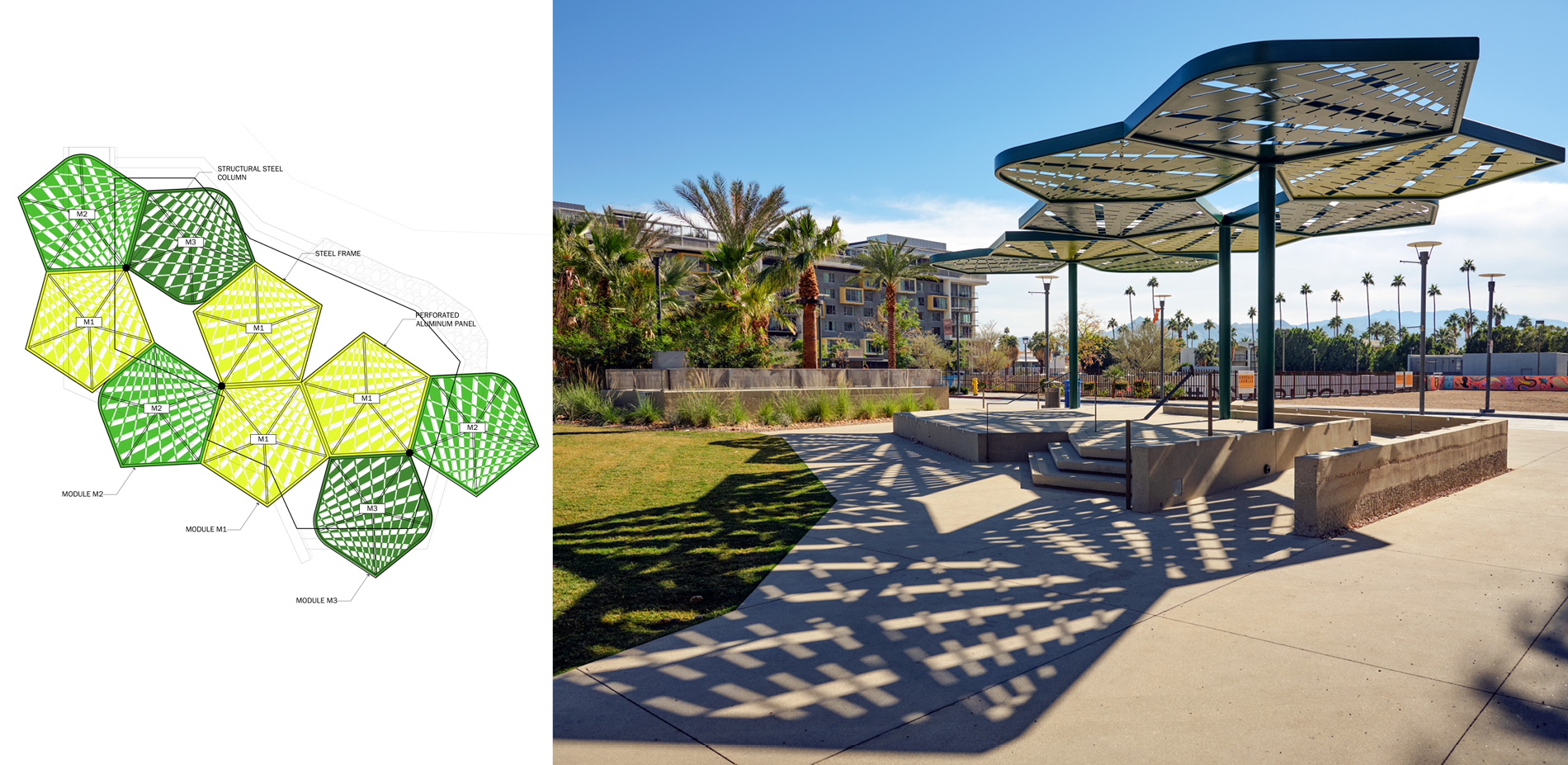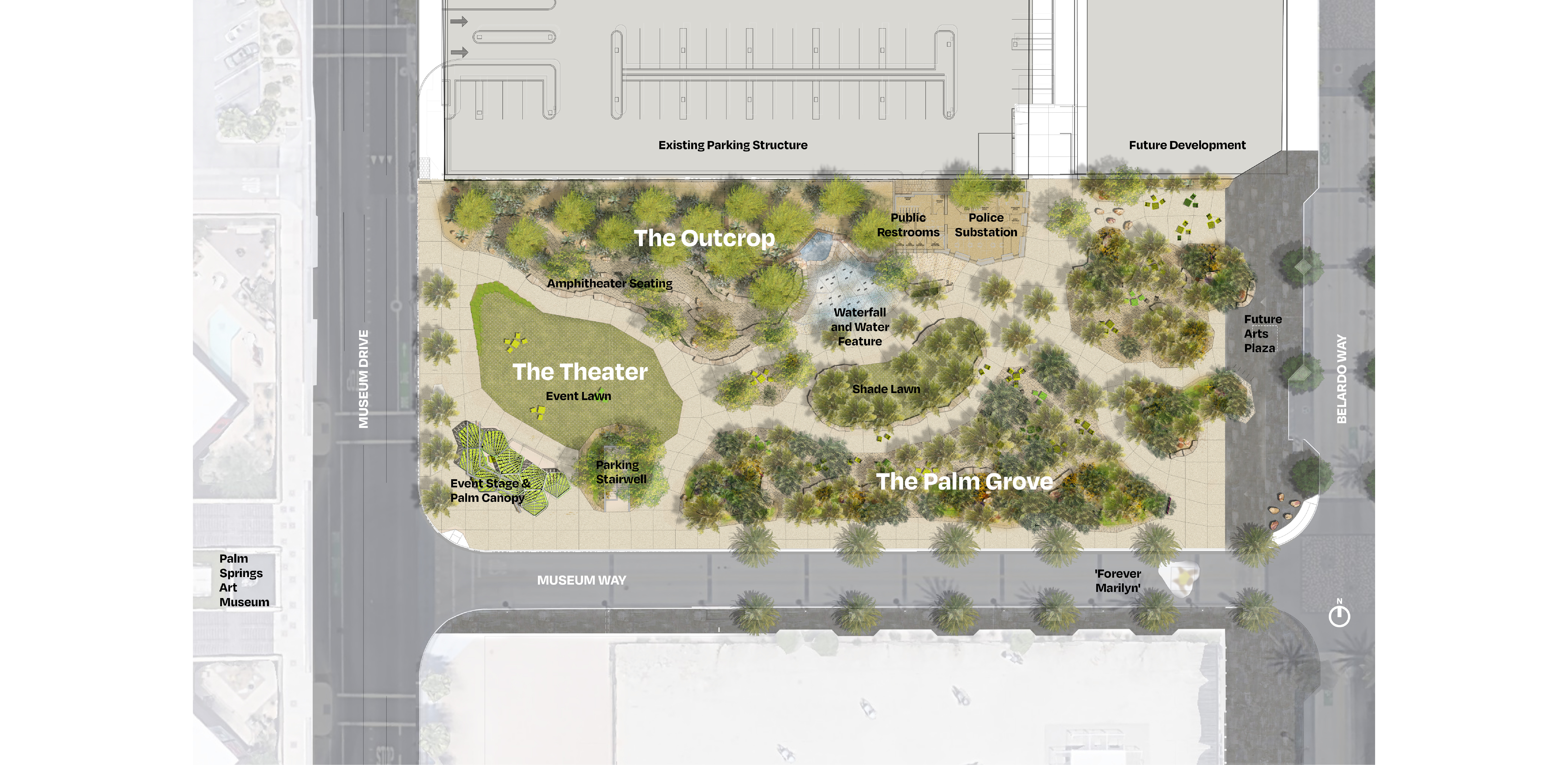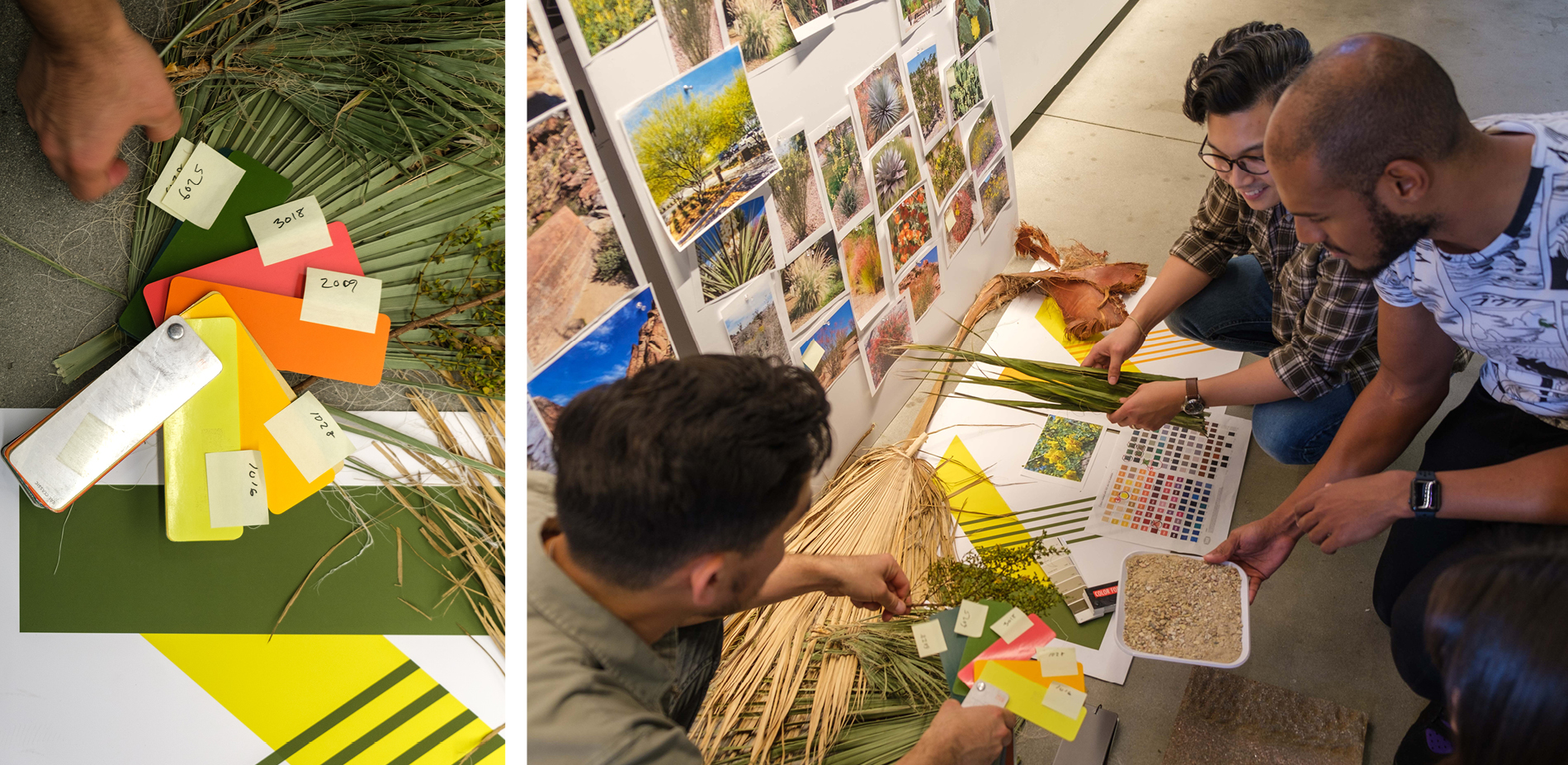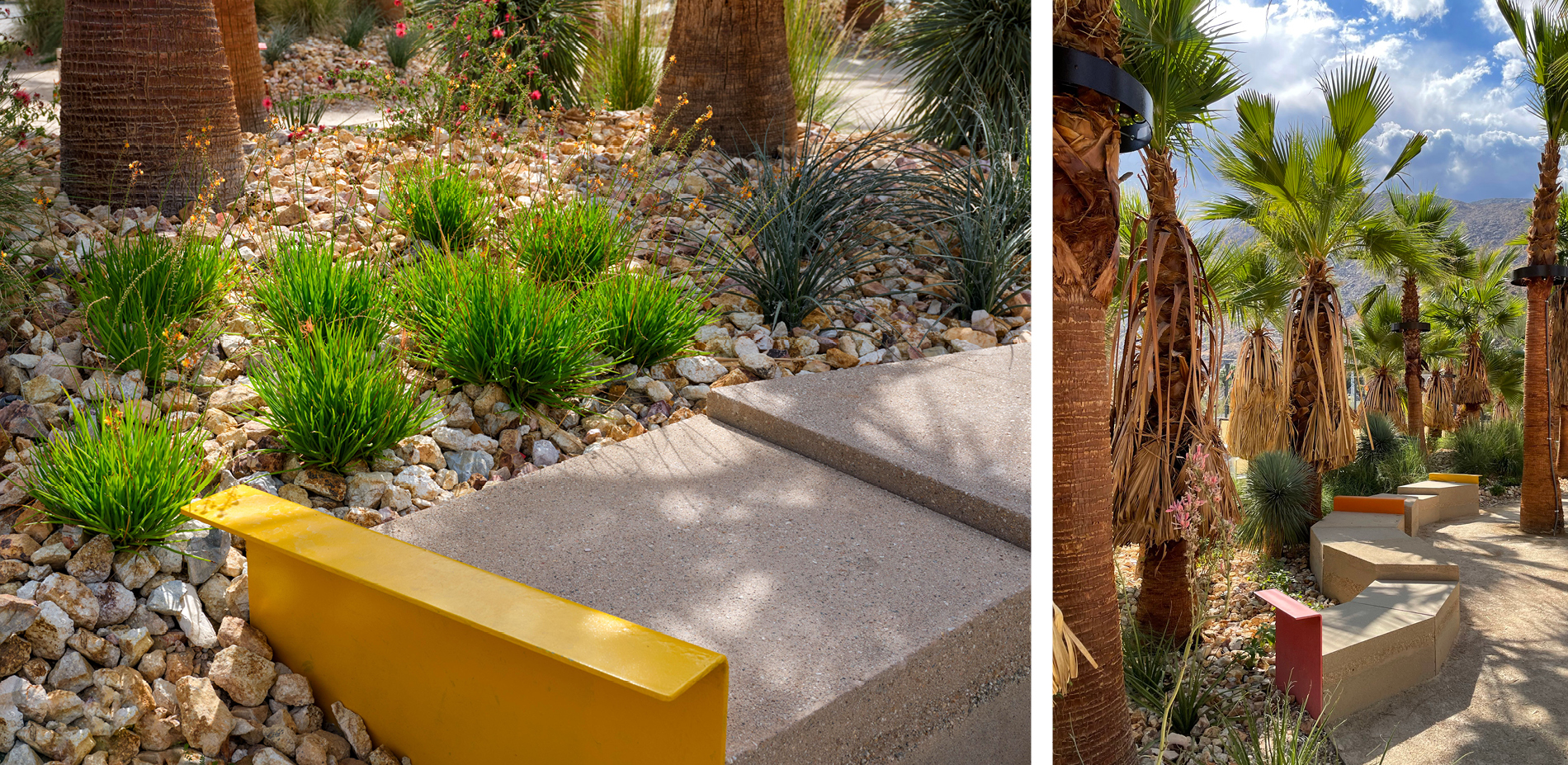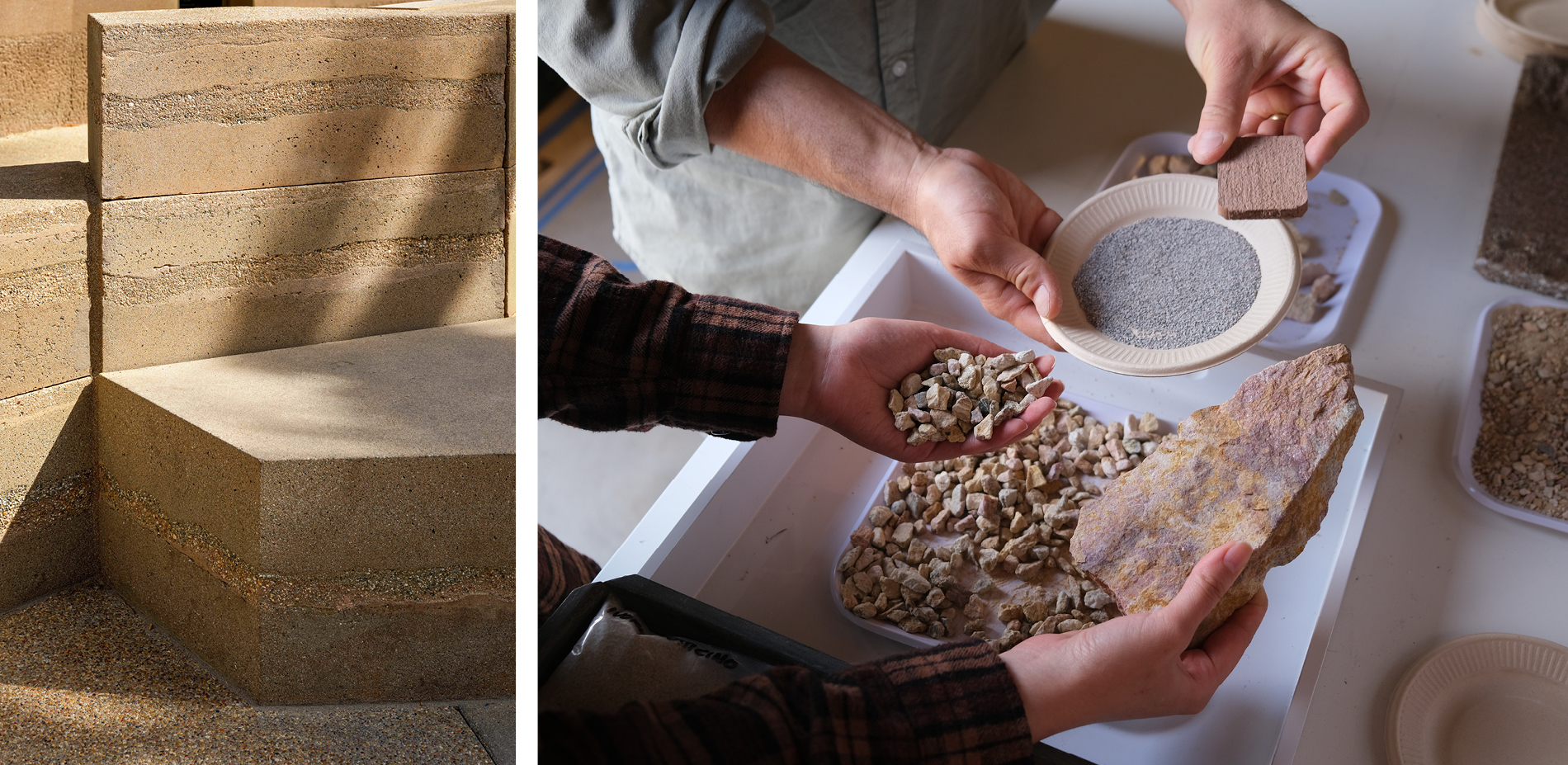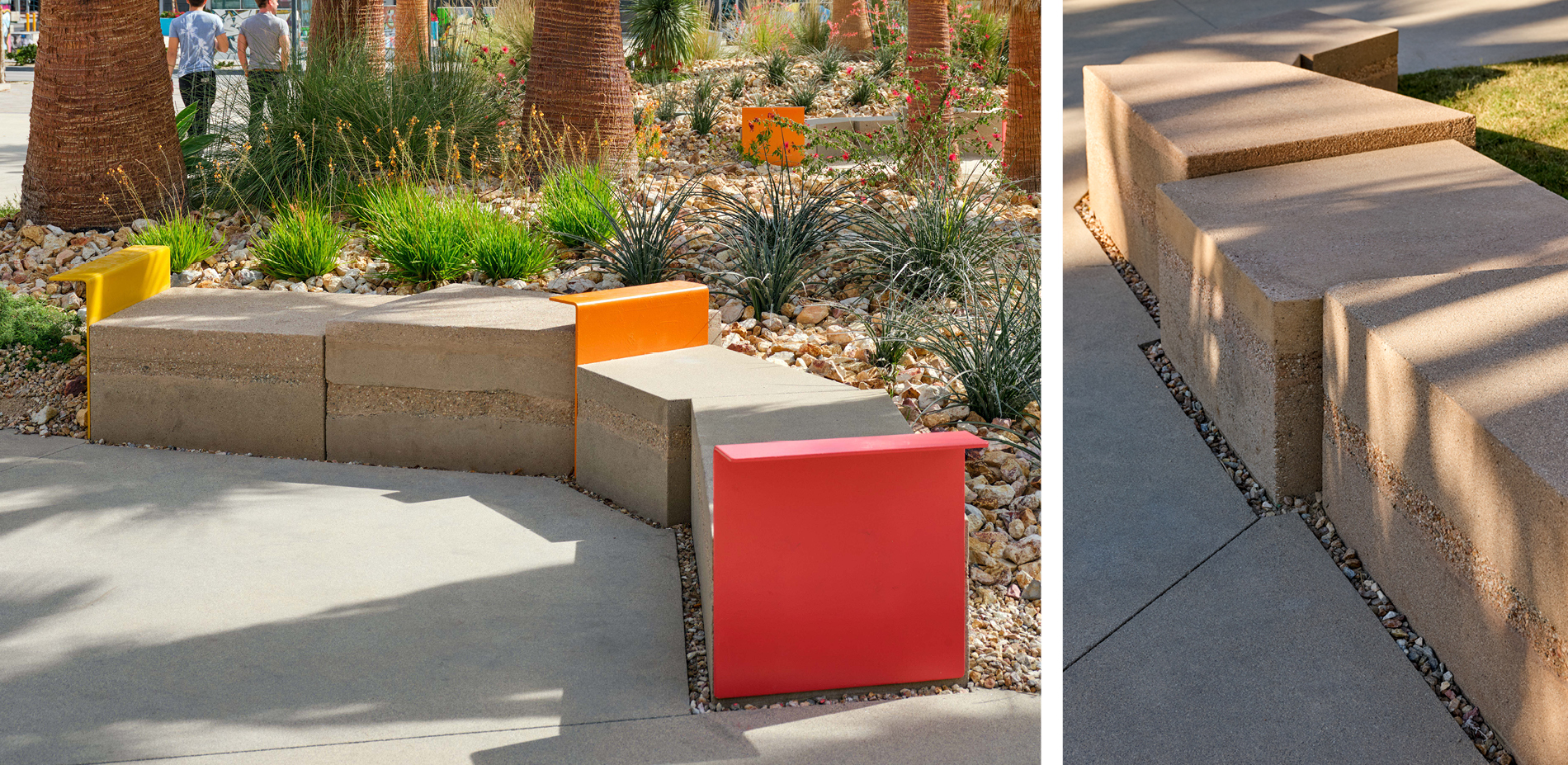Palm Springs Downtown Park
Award of Excellence
General Design
Palm Springs, California, United States
RIOS
Client: City of Palm Springs
Sited on the grounds of the historic sanitorium resort, the Desert Inn, the design draws on its legacy as a destination for health, nature, and pleasure seekers. The park comprises three overlapping spaces: the Palm Grove, with over 130 Washingtonia filifera, California’s only native palm; the Outcrop, on the park’s northern edge designed as an immersive park experience that relates to the surrounding mountains; and the Theater. Each offers distinct programmatic capacities and reveals facets of the region’s geology, vegetation, and rich history. The park’s dramatic centerpiece is a powerful waterfall and an interactive water feature of jets and fog emitters, which the jury called remarkable!
- 2022 Awards Jury
Project Credits
Mark Rios, Creative Director, RIOS
Nate Cormier, Studio Director, RIOS (Landscape)
Jason Shinoda, Design Director, RIOS (Landscape)
Heejae Lee, Project Director, RIOS (Landscape)
Zhihuang Li, Project Director, RIOS (Landscape)
Tamar Cotler, Designer, RIOS (Landscape)
Laura Kos, Senior Project Designer, RIOS (Architecture)
Crystal Huang, Project Designer, RIOS (Architecture)
May Wang, Project Designer, RIOS (Architecture)
Erin Williams, Senior Project Designer, RIOS (Signage and Wayfinding)
Misato Hamazaki, Project Designer, RIOS (Signage and Wayfinding)
Shaw & Sons, Concrete Consultant
Fast-Track Construction, General Contractor
QCP, Precast Concrete Consultant
Fluidity Design Consultants, Water Feature Design and Engineering
City of Palm Springs, Client
MSA, Civil Engineer
PKA, Structural Engineer
MRC, MEP Engineer and Lighting Design
Sweeney & Associates, Irrigation Consultant
Guidepost Solutions, Security & Technology Consultant
MGAC, Cost Estimating
Project Statement
Palm Springs Downtown Park is an inviting 1.5-acre urban oasis for residents and visitors to Palm Springs, a design-forward desert destination nestled along the base of the San Jacinto Mountains along the southwestern boundary of the Coachella Valley in California's Sonoran Desert. The park lies in the ancestral homeland of the Agua Caliente band of the Cahuilla people who seasonally migrated between the shady palm groves and meltwater creeks of mountain canyons in summer and the hot springs and temperate climate of the valley floor in winter. The park is also located on the historic site of Nellie Coffman’s Desert Inn. An early booster of Palm Springs, Coffman stressed the space, stillness, solitude, and simplicity of Palm Springs. Nellie’s “four S’s” would inspire the park’s design, which amplifies the intrinsic qualities of this extraordinary place to immerse visitors in the multisensory beauty of the desert and celebrate Palm Springs’ legacy as a destination for health, nature, and pleasure seekers. The park is made up of three spaces: the Palm Grove, the Outcrop, and the Theater.
Project Narrative
Vision
Palm Springs Downtown Park is an inviting 1.5-acre urban oasis for residents and visitors to Palm Springs, a design-forward desert destination nestled along the base of the San Jacinto Mountains along the southwestern boundary of the Coachella Valley in California’s Sonoran Desert. The park lies in the ancestral homeland of the Agua Caliente band of the Cahuilla people who seasonally migrated between the shady palm groves and meltwater creeks of mountain canyons in summer and the hot springs and temperate climate of the valley floor in winter. The park is also fortuitously located on the historic site of Nellie Coffman’s Desert Inn. An early booster of Palm Springs, Coffman stressed the space, stillness, solitude, and simplicity of Palm Springs. Nellie’s “four S’s” would inspire the park’s design, which amplifies the intrinsic qualities of this extraordinary place to immerse visitors in the multisensory beauty of the desert and celebrate Palm Springs’ legacy as a destination for health, nature, and pleasure seekers. The park is made up of three overlapping spaces: the Palm Grove, the Outcrop, and the Theater. Each offers distinct programmatic capacities and reveals facets of the region’s dynamic geology, distinctive vegetation, and rich history.
The Palm Grove
The densely planted Palm Grove satisfies the need to achieve thermal comfort in the extreme heat of summer days that can exceed 120 degrees. The tight arrangement of over 130 Washingtonia filifera, California’s only native palm, was inspired by team hikes to Palm Canyon on the Agua Caliente Reservation. The canyon’s sandy floor and continuous canopy formed a cooling cathedral that would significantly influence Downtown Park’s identity. The design team measured air temperatures inside and outside Palm Canyon and mapped the spacing of its palms, most of which retained their frond skirts except where a fire had burned them off and charred their trunks. Some had even been struck by lightning creating a sinuous trunk form known as a “snake palm”. For the park, palms of varying heights were selected for their unique and irregular forms and composed to create shady social eddies of varying sizes. 3D modeling of seasonal shade scenarios was used to ensure coverage throughout the year. Custom aluminum park furnishings stay cool to the touch and are left loose for users to “follow the shade” throughout the day. Visitors move them around to support morning coffee klatches, family picnics, or quiet reading. After dark, the grove is illuminated to glow like a lantern inviting park use into the cooler evening hours.
The Outcrop
The dramatic Outcrop rising along the park’s northern edge was initially conceived to obscure an adjacent parking garage to allow for an immersive park experience that relates to the surrounding mountains. Team hikes in Tahquitz Canyon offered an up-close experience of the colorful banded rock formations which offer such striking views from the valley floor. The team abstracted this geology into a custom “sedimentary” finish for shotcrete vertical walls and pre-cast concrete modular seat blocks that retain slopes and form gathering spaces in the park. The uplifted geologic layers of the Outcrop reflect the ombre of tones that make up the San Jacintos, reddish and rumpled sandstones along the base to desaturated and smooth granite along the top. Meandering trails rise with a landform at the east as the Outcrop becomes the backdrop for the park’s dramatic centerpiece, a powerful cascade inspired by Tahquitz Canyon’s iconic waterfalls. In front of the waterfall is an interactive water feature of jets and fog emitters that cools the heart of the park while bringing the magic of surrounding mountains into the urban core. The Outcrop’s westernmost extent contains park restrooms and a police substation fully integrated into the geologic structure.
The Theater
Park visitors flock to the shade of the Palm Grove and the relief of the Outcrop’s water features to beat the heat during the day, but at night as temperatures come down, the Theater comes to life. This space honors the cultural heritage of Palm Springs and the Coachella Valley, a world-class destination for the performing arts from the days of singing cowboys to contemporary music, dance, and film festivals. The Theater hosts an array of events from live performances, lectures, film nights, and music festivals taking place on an elevated stage with a capacity of over 1000 on the event lawn and amphitheater seat blocks stepping up into the Outcrop. The stage is framed by a palm frond-inspired shade canopy and has a dramatic backdrop of the Palm Springs Art Museum and the San Jacinto Mountains.
Materiality
The materials and the plantings in the park are rooted in the character and natural history of Palm Springs. Local ‘Palm Springs Gold’ stone was sourced from a quarry 10 miles away and used as boulders, cobble mulch, concrete topcast, and decomposed granite to complement the hues and tones of the surrounding mountains. Climate-appropriate native and regional desert plantings were specified to provide ecological habitat, attract native pollinators such as monarch butterflies and hummingbirds, and showcase the biodiversity of the desert. Mesquite and Palo verde trees provide shade and anchor a more arid and sculptural palette of ocotillo, agave, and barrel cactus on the Outcrop. Hesperaloe, bulbine, and desert milkweed are among the more colorful species in the Palm Grove planting areas, which also contain a series of rain gardens receiving and filtering all stormwater from the park. Armrests on the seat blocks increase accessibility while offering pops of vibrant color sampled from the blooms of surrounding flora.
Products
-
Furniture
- Janus et Cie – ‘Civic Line’ – Café chairs and table line
- Landscape Forms – ‘Bola' – Bike Rack
- Elkay – Outdoor Pedestal Water Fountain
-
Irrigation
- Rainbird – Irrigation System
-
Hardscape
- Shaw & Sons – Integral Colored Concrete
- Belgard – Victorian Blend Brick PaversWhitewater Rock & Supply – Decomposed Granite, Crushed Stone, Site Boulders
-
Lighting
- Bradley Lighting – Landscape Lighting and Post Lights
Plant List
- ‘Desert Museum’ Palo Verde – Parkinsonia x ‘Desert Museum’
- Deglet Nour Date Palm – Phoenix dactylifera ‘Deglet Nour’
- Thornless Hybrid Mesquite - Prosopis x ‘Phoenix’
- Hybrid Fan Palm – Washingtonia x ‘Filibusta’
- California Fan Palm – Washingtonia filifera
- Variegated Foxtail Agave – Agave attenuata ‘Variegata’
- Desert Milkweed – Asclepias subulata
- Tangerine Stalked Bulbine – Bulbine frutescens ‘Tiny Tangerine’
- Sundrops – Calylophus hartwedii v. fendleri
- Sierra Starr Fairy Duster – Calliandra 'Sierra Starr’
- Sierra Gold Lemon Dalea – Dalea capitata 'Sierra Gold'
- Black Dalea – Dalea frutescens ‘Sierra Negra’
- Rock Verbena – Glandularia pulchella
- Desert Dusk Hesperaloe – Hesperaloe parviflora 'Desert Dusk'
- Desert Flamenco Hesperaloe – Hesperaloe parviflora 'Desert Flamenco'
- Pink Parade Hesperaloe – Hesperaloe x 'Perfu' ‘Pink Parade'
- Mexican Honeysuckle – Justicia spicigera
- Lindheimer Muhly – Muhlenbergia lindheimeri 'Autumn Glow'
- Mexican Oregano – Poliomintha maderensis ‘Lavender Spice’
- Big Bend Yucca – Yucca rostrata
- Whale's Tongue Agave – Agave ovatifolia
- Purple Three Awn – Aristida purpurea
- Desert Milkweed – Asclepias subulata
- Desert Marigold – Baileya multiradiata
- Sundrops – Calylophus hartwegii v. fendleri
- Grey Desert Spoon – Dasylirion wheeleri
- Golden Barrel Cactus – Echinocactus grusonii
- Brittlebush – Encelia farinosa
- Ocotillo – Fouquieria splendens
- Yellow Yucca – Hesperaloe parviflora 'Yellow'
- Desert Lavender – Hyptis emoryi
- Chuparosa – Justicia californica
- Creosote – Larrea tridentata
- Lindheimer Muhly – Muhlenbergia lindheimeri 'Autumn Glow'
- Deer Grass – Muhlenbergia rigens
- Hardy Spineless Prickly Pear – Opuntia canacapa 'Ellisiana'
- Desert Mallow – Sphaeralcea ambigua
- Arizona Rosewood – Vauquelinia californica
- Soaptree Yucca – Yucca elata




